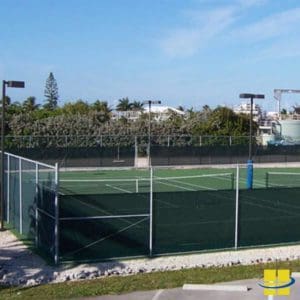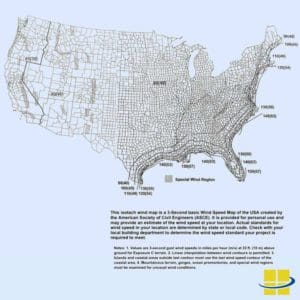 If it is time to purchase new flood or area lighting to illuminate a large outdoor area for sports, a parking lot, a port, or a freight terminal, the project will likely require the selection and installation of new light poles. How do you make the correct light pole selection? Consider wind, weight and effective projected area, Let’s find out.
If it is time to purchase new flood or area lighting to illuminate a large outdoor area for sports, a parking lot, a port, or a freight terminal, the project will likely require the selection and installation of new light poles. How do you make the correct light pole selection? Consider wind, weight and effective projected area, Let’s find out.
While many Access Fixtures tennis courts, basketball courts, and other LED sports lighting packages include poles, the poles in these standard packages may not suffice for your location. Why? First and foremost, luminaire or pole assemblies must be designed to ensure structural integrity during wind conditions specific to your location, taking into account factors such as air density and drag coefficient. Standard flood, area, or sports lighting packages from Access Fixtures are designed to meet 90 MPH wind speed requirements, though this threshold may need to be higher if you are located near the coast or in a particularly windy area. It is crucial that you consider your wind speed zone to make sure your fixtures and poles are equipped for your project. Other factors to consider when making your light pole selection are the types of luminaire you’re using, the quantity of those luminaries, and local building codes. Let’s explore the aspects of flood and area light pole selection and how to get it done right.
How the Type and Quantity of Luminaires Affect Light Pole Selection
The type of luminaire, the number of luminaires per light pole, and the type of mounting bracket used to attach the luminaires to the poles all affect the structural requirements of a light pole. The type of luminaire makes an enormous difference, as each luminaire housing has a unique effective projected area (EPA), also known as effective projected area epa. The EPA is the exposed surface area of a light fixture or bracket multiplied by a shape factor. An EPA can be calculated manually, but it is easier to check the luminaire specifications provided by the manufacturer. To determine the total EPA of a pole, an engineer will add the EPA of the light fixture multiplied by the number of light fixtures and the EPA of the mounting hardware times the quantity of each piece of hardware. The total weight of all the light fixtures and mounting hardware has to be added up, too. It is also important to consider how the fixture is mounted, as this can affect the overall stability and wind resistance. Any other brackets, signs, decorations, overhead wires, or other equipment that will be mounted on the light pole must be taken into consideration. If this all sounds confusing, don’t worry: An Access Fixtures lighting specialist will be glad to calculate the total EPA and weight factors for your project.
Let’s explore the aspects of flood and area light pole selection and how to get it done right. For instance, flood lights require careful consideration of their EPA to ensure they can withstand wind forces.
How Wind Loads and Wind Maps Affect Light Pole Selection
Luminaire and pole assemblies must be designed to maintain their structural integrity when subjected to wind forces. To make it easier to determine the wind speed in your specific location, the American Society of Civil Engineers has created a wind speed map shown on the right. To get an idea of the wind speed in your area, click on the image to download a full-sized PDF and then find your location. If your location falls between, or on, an isotach bar, use the next highest wind velocity (e.g., if your project is on the 90 MPH bar, assume your wind zone to be 100 MPH). Please note that this isotach map is provided for your reference and will only provide an estimate of the wind speed in your area. Understanding the wind pressure in your area is crucial for determining the appropriate light pole design.
Wind Loads and Light Pole Design
Wind loads play a crucial role in the design of light poles, especially for outdoor lighting fixtures. Wind load refers to the force exerted on a light pole by wind, which can cause the pole to sway, vibrate, or even collapse if not properly accounted for. To ensure the structural integrity of light poles, engineers and designers must consider wind loads in their design calculations.
Several factors influence the wind load on a light pole, including wind velocity, wind direction, and the shape and size of the pole. Wind velocity is particularly critical as it determines the magnitude of the wind force acting on the pole. Wind speeds can vary significantly depending on the location, with coastal areas typically experiencing higher wind speeds than inland regions.
To mitigate the effects of wind loads, light pole designers employ various techniques:
- Material Selection: Using materials with high strength-to-weight ratios, such as steel or aluminum, helps minimize the weight of the pole while maintaining its structural integrity.
- Pole Shape: Designing the pole with a tapered or conical shape reduces wind resistance, making it more stable in high wind conditions.
- Installation Angle: Installing the pole at an angle can help reduce the wind force acting on it, enhancing its stability.
- Support Systems: Utilizing guy wires or other support systems can provide additional stability, especially in areas prone to high wind speeds.
By carefully considering wind loads in the design of light poles, engineers and designers can ensure that outdoor lighting fixtures are safely and securely installed, even in areas with high wind speeds. This attention to detail helps prevent structural failures and ensures the longevity and reliability of the lighting system.
When Do Building Codes Affect Light Pole Selection?
Always. Building codes always affect light pole selection. Mountainous areas, coastal areas, and areas surrounding the Great Lakes are known to have wind velocities that are considerably higher than the surrounding areas, but the maximum wind velocity and wind ratings can even vary from one side of town to the other. Consequently, the reference map only provides an estimate of wind speed.
A customer in Florida used the address at his previous home to determine the wind speed of his new home in the next town over, where he was installing the new lighting. That new town had a much higher wind speed requirement than his current home and the poles he ordered were not sufficient for his project.
To find out the wind speed requirements for your location, consult with your local building code department. Building code departments know what the standard is for your location, be it a standard for the entire town or a standard for your immediate location. Your lighting and pole assemblies will have to meet the building code for your specific location. Ensuring that your fixtures meet the required wind rating is essential for compliance and safety.
Using the Data to Determine the Correct Light Pole Selection
Poles are selected to meet specific requirements. The selection process also takes into account the specific lighting fixture being used to ensure compatibility and safety. Many companies have charts that help determine the correct pole. Once Access Fixtures knows the height at which the luminaires are supposed to be mounted, the weight of the luminaires, the weight of the mounting hardware, the total EPA, and the epa wind rating, we can pair you with the perfect luminaire-pole setup.
Is an Engineer Required to Select the Correct Light Pole?
An engineer is typically not required to select the correct light pole, but you may need one to permit and install the correct light pole. Selecting the correct light pole can oftentimes be done by an engineer or light pole specialist at the company supplying the pole, taking into account the fixture’s wind rating. As long as all the criteria, such as wind speed for the location, total EPA of the luminaires and mounting hardware, weight of the luminaires and mounting hardware, and mounting height of the luminaires are available, selecting the correct light pole is a straightforward exercise for a pole supplier.
An engineer may still be required to permit and/or install the correct light poles. Local soil conditions will determine the type of base/foundation required for your light poles; the municipal building code department for your location will have to decide if the base/foundation needs to be specified by an engineer. If it does, you would provide a combined design of the base and pole with engineer’s stamp or signature. Providing an engineer-stamped design is a basic task performed by local engineers. The structural aspect of the design is crucial to ensure the stability and safety of the installation. Stamped drawings can typically be supplied by for a small fee.
Speak to an Access Fixtures Lighting Specialist about Choosing the Outdoor Lighting Pole EPA
It is important to know what you’re buying. We’re here to give you all the information you need. We want to make sure you get the exact pole for your needs, your budget, and your goals. Understanding the projected surface area of your fixtures is essential for accurate EPA calculations and proper pole selection. If you have questions regarding lighting and light poles for your project, speak with an Access Fixtures lighting specialist today by calling (800) 468-9925.

